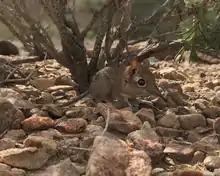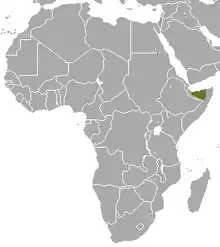Somali elephant shrew
The Somali elephant shrew or Somali sengi (Galegeeska revoilii) is a species of elephant shrew in the family Macroscelididae.
| Somali elephant shrew[1] | |
|---|---|
 | |
| Scientific classification | |
| Kingdom: | Animalia |
| Phylum: | Chordata |
| Class: | Mammalia |
| Order: | Macroscelidea |
| Family: | Macroscelididae |
| Genus: | Galegeeska Heritage & Rayaleh 2020 |
| Species: | G. revoilii |
| Binomial name | |
| Galegeeska revoilii (Huet, 1881) | |
 | |
| Somali elephant shrew range | |
| Synonyms | |
|
Elephantulus revoilii | |
Natural habitat
Its natural habitat is arid and semiarid desert with rocky substrates and sparse shrubs. In some parts of northern Somalia, the Somali sengi and rufous sengi may be locally sympatric. It is found in the northern Horn of Africa; it was formerly thought to be exclusively endemic to Somalia, but a 2020 sighting also indicates they are found in Djibouti and potentially Ethiopia.
Classification
It was formerly classified in the genus Elephantulus, but a 2020 study found it to be the sister taxon of the clade containing the genera Petrodromus and Petrosaltator; due to this, it was reclassified in the monotypic genus Galegeeska.[3] The split with the Petrodromus-Petrosaltator clade is estimated to have occurred about 20.6 million years ago.[3]
Disappearance and rediscovery
The Somali sengi was among the 25 "most wanted lost" species that were the focus of Global Wildlife Conservation's “Search for Lost Species” initiative.[4] On 18 August 2020, 50 years after it was last seen and recorded, it was announced that a population had been found in Djibouti, the first documented since 1968.[5][6][7]
Etymology
Galegeeska translates to "weasel of the horn". In the Somali language, 'geeska' means corner or horn, as in the Horn of Africa. Galê in Ancient Greek means weasel, and has been used in other small mammal taxa. 'Gale' also honours one of the authors, Galen B. Rathbun (1944-2019) who searched for the Somali sengi and devoted several decades of research into sengi biology.[3]
References
- Schlitter, D.A. (2005). "Order Macroscelidea". In Wilson, D.E.; Reeder, D.M (eds.). Mammal Species of the World: A Taxonomic and Geographic Reference (3rd ed.). Johns Hopkins University Press. p. 83. ISBN 978-0-8018-8221-0. OCLC 62265494.
- Rathbun, G.B. (2015). "Elephantulus revoilii (errata version published in 2017)". IUCN Red List of Threatened Species. 2015: e.T7137A117060302. Retrieved 18 August 2020.CS1 maint: ref=harv (link)
- Heritage, S.; Rayaleh, H.; Awaleh, D.G.; Rathbun, G.B. (2020). "New records of a lost species and a geographic range expansion for sengis in the Horn of Africa". PeerJ. 8: e9652. doi:10.7717/peerj.9652. PMC 7441985. PMID 32879790.
- "The Search for Lost Species". Global Wildlife Conservation.
- Carrington, Damian (18 August 2020). "Tiny elephant shrew species, missing for 50 years, rediscovered". The Guardian. Retrieved 18 August 2020.
- Helen Briggs: Elephant shrew rediscovered in Africa after 50 years, on: BBC news, 18 August 2020
- Enrico de Lazaro: Scientists Rediscover Long-Lost Species of Mammal: Somali Sengi, on: sci-news, 20 August 2020
